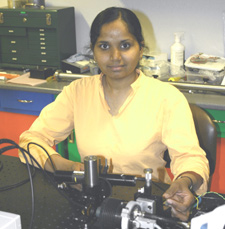Using Ge etalon in gas sensing
project involving quantum cascade lasers
 |
Jagadeeshwari (Esha) Manne, PhD student, University of
AlbertaProject: Infrared absorption
spectroscopy with Quantum cascade laser.
The advance of Quantum
cascade (QC) lasers fabricated by band structure engineering offers an
attractive new option for IR absorption spectroscopy. QC-DFB lasers are of
particular interest to gas-sensing applications because they emit single
frequency radiation which falls within the 3-15 um window, where the
fundamental absorption bands of most of the molecules are located.
Research Activities:
- QC laser characterization
- Exploring different strategies for trace gas detection and comparing
the detection limits and sensitivity for open-path measurements.
|
I am a
graduate student pursuing my doctoral studies at the University of Alberta. The
Ge- etalon will be used for non-profit research here at the university. I am
presently working on a gas sensing project involving Quantum cascade laser.
The mid-IR
region is ideally suited for absorption spectroscopy since the fundamental
vibrational transitions of a number of molecules lie here. Quantum cascade (QC)
lasers
fabricated by band structure engineering offer an attractive
new option for sensitive IR absorption spectroscopy. Distributed feed-back
pulsed QC lasers are of particular interest for they allow the realization of a
room temperature, compact IR source with relatively high output power. In
particular, their combination with the pulsed-CRDS technique
has the potential for high sensitivity trace gas analysis. The goal
of our present work is to develop a technique for quantitative online analysis
of trace constituents in exhaled breath. We are using pulsed-CRDS technique in
combination with a mid IR QC laser operating near 970 cm-1
to measure ammonia levels in exhaled breath. An unlocked
ring-down cavity was designed for these studies which can be operated at
atmospheric or reduced pressure. We have already attained a detection limit of
25 ppb for ammonia. We are in a process of improving the system to get down to
sub ppb levels with this technique.
The etalon will be used for
characterization of the laser which would be an important step in choosing the
right parameters for the laser for gas-sensing applications.
Del Mar Ventures>
Product list>
Precision Optics> Ge
etalon>
